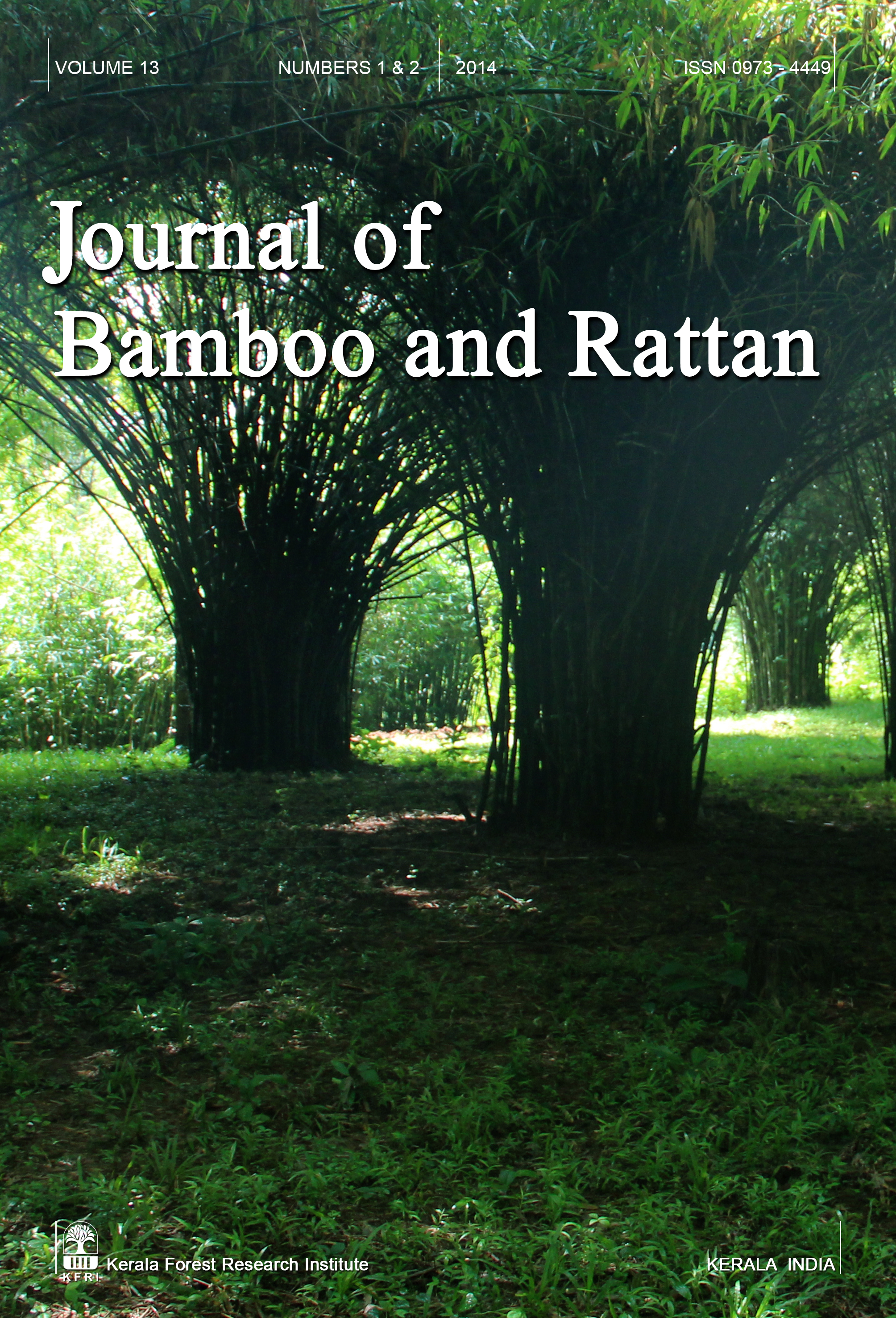Status and distribution of forest-based artisans in Assam, India
DOI:
https://doi.org/10.55899/Keywords:
Artisans activity, income generation, forests resources, livelihoods, bamboo, rattanAbstract
In northeast India, making of cane and bamboo products has been practiced for centuries and is perhaps the most widely used of all the crafts practiced by a large number of artisans scattered throughout
the region. The study was carried out in Assam covering 76 villages in 29 Community Development Blocks falling under 11 districts of the states. The estimated mean number of artisan households per village in the state was 12.33 with a standard deviation of 5.82. The forest based artisan activity was quite intense in the central, western and southern parts of the state. The most active group in terms of the type of products made was the Group-IV including the eastern districts of Dhemaji, Dibrugarh, Jorhat, Sibsagar and Tinsukia. The concentration of artisan households per village was more in the western and southern part of the Assam. Most artisans in the western and south western districts (Group-I ) and the southern districts (Group-VI ) were bamboo based while artisans in remaining Groups-II, III, IV and V were involved in cane based activities. Contribution of artisan activities in rural employment is greater than the employment generated by medium or large wood based industry. Artisan activities need to be encouraged for enhancing the livelihoods of rural poor through skill development.
References
Arnold, J.E.M. and Perez, M.R. 2001. Can non-timber forest products match tropical forest conservation and development objectives? Ecol. Econ. 39: 437-447
Banerjee, A. and Madhurima C. 2013. Forest degradation and livelihood of local communities in India: A human rights approach. J. Hortic. Forest. 5(8): 122-129.
Bula, S. 2009. Socio-economic Status of Handicraft Women among Macca Oromo of West Wallaga, Southwest Ethiopia. Newsletter the African Diaspora Archaeology Network.
Contreras-Hermosilla, A. 2000. The Underlying Causes of Forest Decline. Occasional Paper No. 30. Center for International Forestry Research, Indonesia. pp. 25.
David, S. and Rajesh, K. 2002. Multimedia Archiving of Technological Change in a Traditional Creative Industry: A Case Study of the Dhokra Artisans of Bankura, West Bengal. Springer-Verlag London Limited AI & Soc 16: 350-365.
Fisseha, Y. 1987. Basic features of rural small-scale forest-based processing enterprises in developing countries. In: Small-scale forest based processing enterprises. Forestry Paper, FAO, Rome, pp. 79.
Fisseha, Y. and Milimo, J. 1986. Rural small-scale forest-based processing enterprises in Zambia: report of a 1985 pilot survey. FO: MISC/86/15. Rome, FAO.
Kilby, P. and Liedholm, C. 1986. The role of non-farm activities in the rural economy. EEPA Discussion Paper No. 7 delivered December 1986 at the 8th World Congress of the Int. Economics Assoc., New Delhi, India.
Page, J. and Steel, W. 1984. Small enterprise development: economic issues from African experience. Technical Paper No. 26. Washington, D.C., USA, World Bank.
Pal, M.K. 1978. Crafts and Craftsmen in Traditional India. Kanak Publications, New Delhi.
R Core Team, 2013. R: A language and environment for statistical computing. R Foundation for Statistical Computing, Vienna, Austria. URL http://www.Rproject.org/.
Sarkar, S. 1998. Indian Craft-Technology: Static or Changing – A Case Study of the Kansari's Craft in Bengal, 16th to 18th Centuries. Ind. J. Hist. Sc. 33: 131–142
Welch, S.C. 1986. India, Art and Culture. Mapin Publishing, New Delhi
Socio-Economic and Educational Development Society, 2006. Status study of tribal handicraft- an option for livelihood of tribal community in the states of Arunachal Pradesh, Rajasthan, Uttaranchal and Chhattisgarh.
Sushil, S. and Sharmistha, B. 2003. Small and Medium Forest Enterprise in India. Discussion paper by Winrock International India, New Delhi in collaboration with International Institute for Environment and Development.
Sunderlin, W.D., Dewi, S., Puntodewo, A., Müller, D., Angelsen, A. and Epprecht, M. 2008. Why forests are important for global poverty alleviation: a spatial explanation. Ecol. Soc. 13: 24
Downloads
Published
Issue
Section
License
Copyright (c) 2025 Journal of Bamboo and Rattan

This work is licensed under a Creative Commons Attribution-NonCommercial-ShareAlike 4.0 International License.
How to Cite
Similar Articles
- Gaddam Sudharshan Reddy, M. V. Durai, Guadua angustifolia Kunth: Effect of age on growth, culm morphology, and biomass production , Journal of Bamboo and Rattan: Vol. 23 (2024): Issue 3
- Alok Yadav, Sanchili Verma, Rahul Nishad, Kuldeep Chauhan, Bambusa vulgaris blooms along the Eastern plains of Uttar Pradesh , Journal of Bamboo and Rattan: Vol. 22 (2023): Issue 3
- Krishnapriya K R , Sreekumar V. B., Syam Viswanath, Physical and anatomical variations in culm characteristics of Pseudoxytenanthera bourdillonii (Gamble) H.B.Naithani – a lesser studied endemic bamboo in the Western Ghats, Kerala , Journal of Bamboo and Rattan: Vol. 23 (2024): Issue 2
- S. Sneha, Siljo Joseph, Arun Christy, VB Sreekumar, Divya Menon, Taxonomic studies on the lichenized fungi inhabiting bamboos and rattans of KFRI Peechi campus , Journal of Bamboo and Rattan: Vol. 22 (2023): Issue 4
You may also start an advanced similarity search for this article.
